Fabric’s fascinating journey – from Egyptian shrouds to high-tech tops
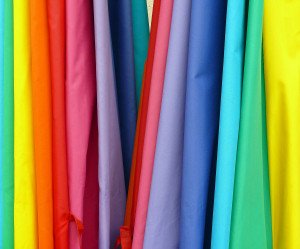 We have been using fabric from prehistoric times, and ever since it has been a fundamental part of our lives.
We have been using fabric from prehistoric times, and ever since it has been a fundamental part of our lives.
Fabrics have come an awfully long way from the basic felt items of our caveman ancestors, with dyes and synthetic textiles expanding its properties and uses.
From essential clothing to ostentatiously artistic creations – our universal love of fabric for both adornment and expression has never ceased.
In the beginning
As far as historians can tell the first use of woven textiles, rather than just animal hides, dates back roughly 100,000 years. Discovered in a Neolithic site in Anatolia, these surviving examples of textiles are believed to date from 6500 BC. Made from a very basic form of felt; it would have been produced on a loom and then tied in place.
Four all-natural fabrics
For thousands of years there were only natural fabrics, name from the fibres of flax, silk, cotton and wool. These fabrics were all produced from renewable and natural sources.
Linen
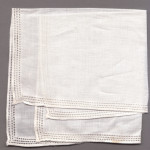
A soft linen handkerchief
Around 5000 BC, the Egyptians began to produce linen. It was made from wild flax and spun or spliced to make the yarn. The Egyptians used linen to make bandages for mummification and as items of clothing. There are examples of Egyptian wall art depicting pharaohs, such as Neferatar, wearing linen dresses and shirts.
The use of linen grew and spread and by Roman times it became popular to wear linen under other garments. And so it was that by the Middle ages wearing linen in this manner became so popular that the word “linen” became to mean the same as underwear, in fact word ‘lingerie’ is derived from it.
Cotton
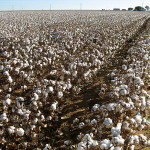
Cotton fields
Between 5000 and 3000 BC cotton came into existence. There is evidence that people of ancient China, India and Egypt were spinning, weaving and dying cotton.
By 400 BC India had began to produce cotton textiles on a bigger scale. Records show growers planting out cotton fields and carvings from this time depict cotton rolling machines used to remove the seeds from the fibres.
In 1884 the invention of the power loom brought with it vast improvements to the speed of cotton production.
Wool
In very early times, around 10,000 BC, people began to keep sheep to breed for meat. The wool was much shorter and coarser than the sheep’s wool we know, not really woolly at all. But as the best sheep were kept for breeding their wool became more useful, and by 5000 BC their wool was good enough to spin well.
By 3000 BC there were approximately 40 different breeds of sheep, which produce more than 200 types of wool.
In the Middle Ages woollen garments were popular in Europe. Worn over linen, the wool would create a thick warm outer layer.
Silk
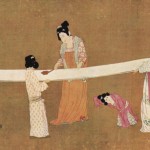
Early silk production in China
It is believed that silk was discovered by a Chinese princess around 2500 BC. Silk is made from two threads joined together and used to form the cocoon of silkworm. These worms only eat the leaves of the mulberry bush, a plant native of East Asia, so for a long time silk production only took place in parts of China and Japan.
During the Han Dynasty, around 114 BC, The emperor started the infamous Silk Road, a set of treacherous trails that would enable people in other parts of Asia, and later Europe, to purchase silk.
Colours and prints
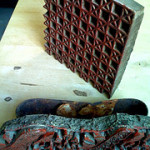
Antique fabric printing blocks
Printing onto fabric dates back as far as the fourth century, in China. The two main printing methods – block and screen, began to be used throughout Asia and India, then later Europe. These two techniques have been used to create intricate repetitive patterns on fabrics ever since, with industrialisation, speeding up the process dramatically.
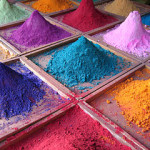
Vibrant Indian pigments
Once again it was China that led the way, this time as one of the first places to starting dyeing textiles, around 5000 years ago. They used natural dyes from insects and plants to produce vividly colour silks and linens.
Synthetic dyes have only been around since the 19th century, and the first of these was discovered accidentally by the English Chemist William Perkins.
Man-made fabric
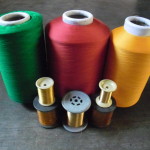
Reels of polyester thread
Compared to the long history of natural textiles the use of synthetic fibres is a very new development, only appearing around a hundred years ago. Experiments began to see if some problems with natural fabrics, such as its lack of elasticity or wrinkling, could be solved.
It took over two hundred years for scientists to get these artificial fibres right. Finally, a British chemist, Sir Joseph Swan, produced the first synthetic fibre and unveiled it at the International Inventions Exhibition in London in the early 1800s.
The fibres of synthetic fabrics are made from synthesised molecules, which come from compounds of chemicals such as petroleum.
From this development would come a whole range of man-made fibres. And from 1910 onwards we’d see the creation of fabrics such as Rayon, Nylon, Acrylic, Polyester, Spandex and later Micro Fibres.
The future of fabric

Smart fabric used to create a digital dress
What is next for fabric? Smart textiles! These are fabrics with all sorts of technological enhancements, be it to improve performance or make them more aesthetically pleasing. Fabrics are being developed that can light up and change colour. What’s more, some of them will be able to harness light, heat and sound to create a garment that reacts to its wearer or the environment.
Fabric has come a long way from its simple felt origins, but what is noticeable is that some all-natural fabrics such as pure silk have proven pretty hard to improve on.
Indeed, many gorgeous garments featured on the most recent catwalks come from fabrics that have been in existence for over 5000 years – sometimes it is hard to improve on perfection.
